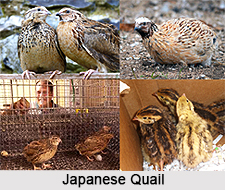 Japanese quail, which is known as Coturnix quail (Coturnix japonica) is a species of Old World quail found in East Asia.
Japanese quail, which is known as Coturnix quail (Coturnix japonica) is a species of Old World quail found in East Asia.
Japanese quail was first considered a subspecies of the Common quail, it was distinguished as its own species in 1983.
Japanese quail has played an active role in the lives of humanity since the 12th century, and continues to play major roles in industry and scientific research. Where it is found, the species is abundant across most of its range.
Population of Japanese Quail
The populations of the Japanese quail are known to mainly inhabit East Asia and Russia. This includes India, Korea, Japan, and China. Though several resident populations of this quail have been shown to winter in Japan, most migrate south to areas such as Vietnam, Cambodia, Laos, and southern China. This quail has also been found to reside in many parts of Africa, including Tanzania, Malawi, Kenya, Namibia, Madagascar, and the area of the Nile River Valley extending from Kenya to Egypt. The breeding sites of the Japanese quail are largely localized to East and Central Asia, in such areas as Manchuria, south-eastern Siberia, northern Japan, and the Korean Peninsula. However, it has also been observed to breed in some regions of Europe, as well as Turkey.
Concentration of Japanese Quail
Japanese quail is primarily a ground-living species that tends to stay within areas of dense vegetation in order to take cover and evade predation. Thus, its natural habitats include grassy fields, bushes along the banks of rivers, and agricultural fields that have been planted with crops such as oats, rice, and barley. It has also been reported to prefer open habitats such as steppes, meadows, and mountain slopes near a water source.
 Morphology of Japanese Quail
Morphology of Japanese Quail
The morphology of the Japanese quail differs depending on its stage in life. As chicks, both male and female individuals exhibit the same kind of plumage and colouring. Their heads are tawny in colour, with small black patches littering the area above the beak. The wings and the back of the chick are a pale brown, the back also having four brown stripes running along its length. A pale yellow-brown stripe surrounded by smaller black stripes runs down the top of the head.
Sexes of Japanese Quail
The plumage of the Japanese quail is sexually dimorphic, allowing for differing sexes to be distinguished from one another. Both male and female adults exhibit predominantly brown plumage. However, markings on the throat and breast, as well as the particular shade of brown of the plumage, can vary quite a bit. The breast feathers of females are littered with dark spots among generally pale feathers. Contrastingly, male breast feathers show off a uniform dark reddish-brown colour that is devoid of any dark spots. This reddish brown coloration also appears in the male cheek, while female cheek feathers are more cream coloured. Some males also exhibit the formation of a white collar, whereas this does not occur in any female members of the species. It is important to note that while this coloration is very typical of wild populations of Coturnix japonica, domestication and selective breeding of this species has resulted in numerous different strains exhibiting a variety of plumage colours and patterns. The males tend to be smaller than females. Wild adults weigh between 90 and 100 grams while their domesticated counterparts typically weigh between 100 and 120 grams. However, weight among domesticated lines varies considerably; as commercial strains bred for meat production can weigh up to 300 grams.
Food Habits of Japanese Quail
The diet of the Japanese quail includes many different types of grass seed such as white millet and panicum. They also feed upon a variety of insects, their larvae, and other small invertebrates. The Japanese quail mainly eats and drinks at the beginning and end of the day, this behaviour shown to closely follow the photoperiod. However, they will still perform these actions throughout the day as well. The babies like cracked millet, and cracked sun flower seed, the also like dried mealworms.











